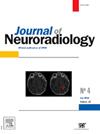Differentiation of tumor progression from pseudoprogression in glioblastoma patients with GRASP DCE-MRI and DSC-MRI
IF 3
3区 医学
Q2 CLINICAL NEUROLOGY
引用次数: 0
Abstract
Purpose
This study investigates the diagnostic accuracy of combined Golden Angle Radial Sparse Parallel Dynamic contrast-enhanced (GRASP DCE-) and Dynamic susceptibility contrast (DSC) MRI in differentiating PD from PsP following RCT in differentiating progressive disease (PD) from pseudoprogression (PsP) following radiochemotherapy (RCT) in glioblastoma patients.
Materials and methods
This retrospective study included glioblastoma patients who underwent surgery and RCT between 2017 and 2021 and developed contrast-enhancing lesions suspicious for PD or PsP and had GRASP DCE- and DSC-MRI. Diagnostic accuracy of perfusion parameters was evaluated using the area under the receiver operating characteristics curve (AUC) at both initial suspicion of progression and confirmation MRI.
Results
Among 83 patients, 62 were classified as PD and 21 as PsP on serial MRI for all patients, with additional histological confirmation in 18 patients. Median perfusion parameters values were higher in the PD group in comparison to the PsP group (rCBV: 3.48 vs. 1.60, p < .001; Vp: 0.08 vs. 0.05, p = .032). At initial suspicion of progression, the combination of Ktrans, Ve, Vp and rCBV improved diagnostic accuracy in differentiating PD from PsP (AUC = 0.77, 95 % CI [0.62–0.93]) compared to rCBV alone (AUC = 0.69, 95 % CI [0.54–0.85]). At confirmation MRI (>12 weeks post-RCT), the added value of DCE was more modest (AUC improvement from 0.88 to 0.90). Suggested optimal thresholds at confirmation were: rCBV 2.87 (Sensitivity 71 %, Specificity 94 %), Ktrans 0.12 min-1 (73 %, 76 %), Ve 0.31 (75 %, 65 %), and Vp 0.05 (78 %, 59 %).
Conclusion
Combining DCE- with DSC-MRI may enhance diagnostic accuracy in distinguishing progressive disease from pseudoprogression in glioblastoma, particularly during the early post-radiochemotherapy phase when treatment decisions are critical. As the added value of DCE-MRI is limited beyond 12 weeks post-radiochemotherapy, the full protocol is best reserved for early suspicion of progression or unclear cases, while DSC-MRI alone may be sufficient for confirmation imaging after this period.

用GRASP DCE-MRI和DSC-MRI鉴别胶质母细胞瘤患者的肿瘤进展与假进展。
目的:探讨黄金角径向稀疏平行动态对比增强(GRASP DCE-)与动态敏感性对比(DSC) MRI联合应用在胶质母细胞瘤放化疗(RCT)后进展性疾病(PD)与假性进展(PsP)鉴别PD与PsP的诊断准确性。材料和方法:本回顾性研究纳入了2017年至2021年间接受手术和RCT的胶质母细胞瘤患者,这些患者出现了怀疑PD或PsP的对比增强病变,并进行了GRASP DCE-和DSC-MRI检查。灌注参数的诊断准确性在最初怀疑进展和确认MRI时使用受者工作特征曲线下面积(AUC)进行评估。结果:83例患者中,所有患者的MRI序列显示62例为PD, 21例为PsP,另有18例患者的组织学证实。PD组灌注参数中位数值高于PsP组(rCBV: 3.48 vs. 1.60, p < 0.001;Vp: 0.08 vs. 0.05, p = .032)。在最初怀疑进展时,与单独使用rCBV (AUC = 0.69,95% CI[0.54-0.85])相比,Ktrans、Ve、Vp和rCBV联合使用可提高PD与PsP的诊断准确性(AUC = 0.77,95% CI[0.62-0.93])。在MRI确认时(rct后12周),DCE的附加值更为温和(AUC从0.88改善到0.90)。建议的最佳确认阈值为:rCBV 2.87(敏感性71%,特异性94%),Ktrans 0.12 (73%, 76%), Ve 0.31 (75%, 65%), Vp 0.06(79%, 59%)。结论:DCE-联合DSC-MRI可提高胶质母细胞瘤进行性疾病和假进展的诊断准确性,特别是在放化疗后早期,治疗决策至关重要。由于放化疗后12周后DCE-MRI的附加价值有限,因此完整方案最好用于早期怀疑进展或不明确的病例,而在此期间后仅DSC-MRI可能足以进行确认成像。
本文章由计算机程序翻译,如有差异,请以英文原文为准。
求助全文
约1分钟内获得全文
求助全文
来源期刊

Journal of Neuroradiology
医学-核医学
CiteScore
6.10
自引率
5.70%
发文量
142
审稿时长
6-12 weeks
期刊介绍:
The Journal of Neuroradiology is a peer-reviewed journal, publishing worldwide clinical and basic research in the field of diagnostic and Interventional neuroradiology, translational and molecular neuroimaging, and artificial intelligence in neuroradiology.
The Journal of Neuroradiology considers for publication articles, reviews, technical notes and letters to the editors (correspondence section), provided that the methodology and scientific content are of high quality, and that the results will have substantial clinical impact and/or physiological importance.
 求助内容:
求助内容: 应助结果提醒方式:
应助结果提醒方式:


